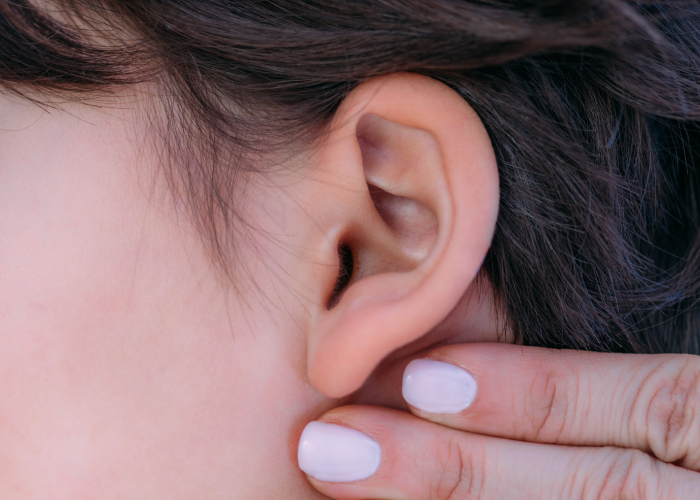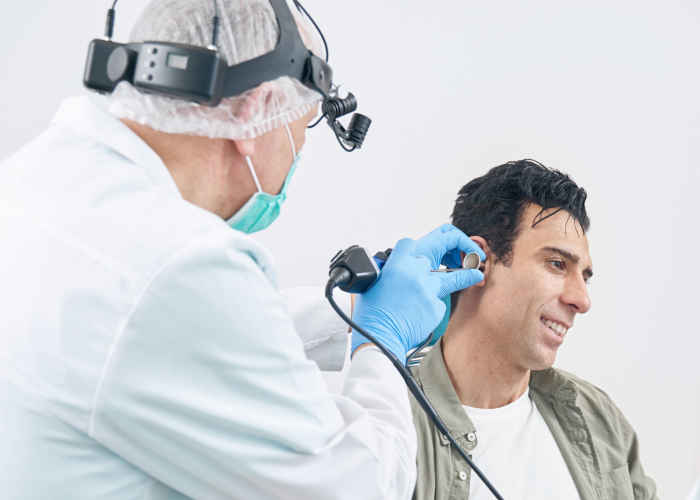Ventilation Tube – Grommet – Insertion
Ventilation Tube – Grommet – Insertion
Our ear is connected to the back of the nose to maintain equal pressure inside and outside of the ear, which is required for proper hearing. When you swallow, a “click” or “pop” sensation in the ear indicates that the tube is functioning normally.
If the Eustachian tube is blocked, the air in the middle ear slowly absorbs, and the eardrum will retract. Eventually, the ear will be filled with fluid to protect the eardrum and middle ear bones.

In the beginning, you will feel a sharp pain, like somebody is punching your eardrum with a needle.
Later on, it will change to a dull pain. If the fluid remains there for a longer time period, it will become like “glue” and could cause reduced hearing.
It might require a glue ear operation.
Consult Dr Levente for glue ear treatment in Dubai.
See if you have any glue ear symptoms.
Sign of the "glue ear"
- poor hearing
- recurrent ear discharge
“Glue ear” could get better by itself, but this can take a while. Therefore, we might ask you to visit the clinic on a regular basis for review. After a couple of weeks, a decision can be made if there is a need to operate.
Advantages of the Grommet insertion
- Ventilating “aerating” the middle ear
- Reducing secretions in the middle ear
- Allowing better eardrum vibration “function”
This gives the ear a chance to recover. Usually, within one year, the Grommet will spontaneously dislodge and fall out once a normal tube function is re-established.

Expectations and advice following grommet insertion
This is usually day-case surgery, but if other procedures need to be carried out as well (e.g. tonsillectomy), an overnight stay may be required
- Avoid getting water into the ears as this may easily cause infection in the ears. This applies to showers, bathing, washing hair as well as swimming. Alternatively, cotton wool heavily smeared with Vaseline is an excellent and sometimes more comfortable alternative
- Swimming is only permitted after the follow-up appointment has given the all-clear
- Avoid diving with a grommet in the ear. Earplugs must be used for all these activities
- If ear discharge persists, smells foul, or there is increased pain or dizziness, seek help as this suggests infection and treatment with antibiotic eardrops will be required
- Pain is normally fairly minimal and can be controlled with simple painkillers
- Grommets usually fall out of the ear in about 9 months. They spontaneously grow out and are ejected by the eardrum and, therefore, very rarely have to be removed. Usually, they fall out of the ear and may be found on the pillow upon waking up. The eardrum usually heals up where the grommet is situated. If your grommet falls out early, do not panic. You do not need to contact your doctor immediately. You should continue keeping your ear waterproof and attend the outpatient clinic as planned.
About Dr Levente
Dr Levente Deak, MD PhD, is a European board-certified nasal surgeon who is an active member of the Royal College of Surgeons and the European Academy of the Facial Plastic Surgery (EAFPS). Has over 15 years of outstanding experience in Rhinoplasty, advanced Endoscopic Sinus Surgery (FESS) and nasal airway management, including nasal septum and turbinate correction. Due to his defined skills, in The Right Nose Clinic, most of the surgical types are minimally invasive, same day procedures.
FAQs
Grommet insertion, also known as grommet surgery, is a procedure primarily for treating glue ear by allowing air to enter the middle ear. It’s often recommended for both children and adults suffering from persistent glue ear that doesn’t respond to conventional treatments.
Ear grommet surgery involves placing a tiny tube through the eardrum to ventilate the middle ear and prevent fluid accumulation. This operation is highly effective as a glue ear treatment, improving hearing and reducing the risk of ear infections.
While the grommet operation remains a standard treatment for glue ear, recent advancements have introduced new treatments for glue ear in adults and children, focusing on less invasive methods and improved long-term outcomes.
Treatment for glue ear in adults often involves grommet insertion, especially if the condition leads to significant hearing loss or recurrent infections. Adults can expect a quick surgery with minimal downtime and significant improvement in symptoms.
The fastest way to address glue ear is through grommet insertion, a surgical procedure where tiny tubes (grommets) are inserted into the eardrum to drain fluid and improve ventilation. This operation offers swift relief from glue ear symptoms.
Flying with glue ear can be uncomfortable due to changes in air pressure during takeoff and landing. It’s advisable to consult with a healthcare professional before flying with glue ear, as they may recommend measures to alleviate discomfort or suggest delaying air travel until the condition improves.
The glue ear itself cannot be removed, as it refers to the build-up of thick fluid in the middle ear. However, treatment options such as grommet insertion or glue ear surgery aim to alleviate symptoms by draining the fluid and restoring normal ear function.
Yes, glue ear can be treated without surgery in some cases, particularly in adults. Non-surgical treatment options may include medications to reduce inflammation or improve fluid drainage, as well as techniques to promote natural ear ventilation. However, if conservative measures are ineffective, grommet insertion or other surgical interventions may be recommended.





